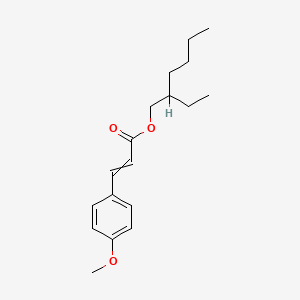
刺激性高嗎?
最少可加多少%?
刺激性高嗎?
最高可加多少%?
最高只可到10% ,刺激性算低 ,
在防曬產品中很常見
日文:
メトキシケイヒ酸エチルヘキシル、
メトキシケイヒ酸オクチル、
パラメトキシケイ皮酸2-エチルヘキシル,
參見:http://www.ba-m-bi.com/seibun/gaiyo/metokisi.htm
干扰正常内分泌。
Extensive research has shown that a number of UV filters frequently used in the formulation of commercial sunscreens, such as 4 MBC, octyl methoxycinnamate, oxybenzone (benzophenone-3), octyl-dimethyl-PABA and octinoxate, possess endocrine activity. Endocrine disruptors are chemicals that interfere with endogenous hormone action and/or production. These have been implicated in the development of a number of diseases in both males and females, including cancer of the mammary glands and reproductive organs, as well as the abnormal development of the male reproductive system. In one study, the application of three active ingredients commonly found in sunscreens (oxybenzone, 4-MBC and octinoxate) for one week led to a drop in testosterone and estradiol levels in men. More worrying is that these chemicals have been found in breast milk at concentrations known to have oestrogenic effects.
這個成分是皮膚炎的過敏原之一,不適合敏感肌用
一個或多個人類病例研究表明可能有光敏性或過敏作用
一個或多個動物的研究表明在高劑量有發展的影響
一個或多個動物的研究表明在高劑量有生殖的影響
一個或多個動物的研究表明在高劑量有肝臟的影響
甲氧基肉桂酸辛酯 (Octinoxate)
作用是以吸收陽光中的中波紫外線(UVB),保護皮膚免於其傷害,是目前最常廣泛使用的 UVB 防曬乳。甲氧基肉桂酸辛酯對皮膚刺激性小,但卻會擾亂荷爾蒙、造成皮膚老化,並產生自由基破壞皮膚細胞。
http://news.everydayhealth.com.tw/2015/06/25/5773-%E8%81%B0%E6%98%8E%E6%8C%91%E9%81%B8%EF%BC%816%E7%A8%AE%E9%98%B2%E6%9B%AC%E4%B9%B3%E5%8D%B1%E9%9A%AA%E6%88%90%E5%88%86%E5%A4%A7%E5%89%96%E6%9E%90
即便在低劑量的情況下,會刺激珊瑚的共生藻體內的病毒攻擊共生藻,間接使珊瑚白化甚至死亡,而共生藻死亡後的病毒被釋入海水後,導致周邊海水病毒濃度增加,提高了其他珊瑚體內共生藻的感染率。
資料來源:環境資訊中心TEIA
Regarding safety, there are also some concerns around Octinoxate. In vitro (made in the lab not on real people) and animal studies have shown that it may produce hormonal (estrogen-like) effects. Do not panic, the studies were not conducted under real life conditions on real human people, so it is probably over-cautious to avoid Octinoxate altogether. However, if you are pregnant or a small child (under 2 yrs. old), choose a physical (zinc oxide/titanium dioxide) or new-generation Tinosorb based sunscreen, just to be on the super-safe side. :)
Overall, Ethylhexyl Methoxycinnamate is an old-school chemical sunscreen agent. There are plenty of better options for sun protection today, but it is considered "safe as used" (and sunscreens are pretty well regulated) and it is available worldwide (can be used up to 10% in the EU and up to 7.5% in the US).
https://incidecoder.com/ingredients/ethylhexyl-methoxycinnamate
https://www.medpartner.club/wp-content/uploads/2017/07/%E9%98%B2%E6%9B%AC%E7%B3%BB%E5%88%975_%E8%A1%A8%E6%A0%BC.png
美的好朋友製作的表格
桂皮酸鹽是常見的防曬劑,全世界通用
由肉桂樹皮所提煉的成分
有少數研究指出,對賀爾蒙有影響,但相關證實還不足夠
所以對孕婦或幼兒少用較佳
潤唇膏上有此成分,吃到會怎樣嗎?Dior的粉漾潤唇膏
Fast facts
Approved in: Certain U.S. states, Europe, Japan, Australia
Banned in: Hawaii, Key West (Florida), Palau
Best for: Sunburn prevention
Coral safe? No, may also potentially affect fish
Found in chemical sunscreens
Octinoxate is a common and potent UVB absorber, meaning it’s effective for sun damage prevention. Combined with avobenzone, they can both provide great broad-spectrum protection against burns and aging.
This ingredient is allowed in formulations (up to 7.5 percent), but is banned in Hawaii due to the environmental risks on coral reefs.
https://www.healthline.com/health/beauty-skin-care/best-sunscreen-ingredients#octinoxate
Not coral reefs and marine life friendly! Belongs to the HEL list of ingredients to avoid while purchasing SPF to protect the marine environment:
The HEL LIST includes:
Any form of microplastic sphere or beads.
Any nanoparticles like zinc oxide or titanium dioxide.
Oxybenzone
Octinoxate
4-methylbenzylidene camphor
Octocrylene
Para-aminobenzoic acid (PABA)
Methyl Paraben
Ethyl Paraben
Propyl Paraben
Butyl Paraben
Benzyl Paraben
Triclosan
(Source: https://haereticus-lab.org/protect-land-sea-certification-3/)
甲氧基肉桂酸乙基己酯、桂皮酸鹽
Octinoxate, also called Octyl methoxycinnamate or (OMC), is a UV filter. It can be absorbed rapidly through skin. Octinoxate has been detected in human urine, blood and breast milk, which indicates that humans are systemically exposed to this compound. [1],[2] Octinoxate is an endocrine disruptor that mimics estrogen and can disrupt thyroid function.
*WHAT IS OCTINOXATE?
Octinoxate filters UV-B rays from the sun. It does not protect against UV-A rays. Octinoxate dissolves in oil, which makes it a fat-seeking substance in the body. It is formed by combining methoxycinnamic acid and 2-ethylhexanol- compounds which are not harmful on their own. When mixed together, they form a clear liquid that does not dissolve in water. It is found in hair color products and shampoos, sunscreen, lipstick, nail polish, and skin creams. [5] In products other than sunscreens, it is used as a UV filter to protect the products from degrading when exposed to the sun.
*Health Concerns
>Endocrine disruption:
Octinoxate increases cell proliferation in cells that grow in response to estrogen exposure. [2],[6],[7] Lifetime estrogen exposure is an established risk factor in the development and progression of breast cancer. Octinoxate affects other hormone systems as well. For instance, it reduces thyroid hormones in blood serum. [8] Thyroid hormones are critical for metabolic functions in the body including mammary gland development. Octinoxate exposure has also been found to alter the reproductive systems of female offspring, with significantly lowered hormone (estradiol and progesterone) levels, [1] which is associated with infertility and miscarriages. In males, there is a reduction in sperm count at all dose levels. [1]
>Reproductive organs and development toxicity:
Numerous studies have reported that octinoxate exhibits antiandrogenic activity, which is linked to harmful effects on reproductive organ development in male and female fetuses exposed in utero. These effects can be further passed onto their offspring. Moreover, octinoxate alters the weight and structure of reproductive organs in male and female rats.[9]
*Vulnerable Populations:
Babies & Children, Pregnant Women, Teenagers, Women of Color
*Regulations
Octinoxate is approved for use in cosmetics worldwide; the maximum concentration in ready-for-use preparations varies according to local legislation. [3] According to the U.S. FDA, the recommended use level is up to 7.5 percent. [4]
Souce: https://www.safecosmetics.org/chemicals/octinoxate/
